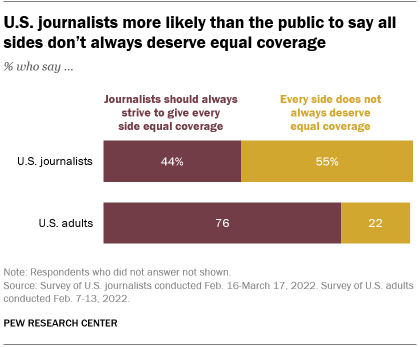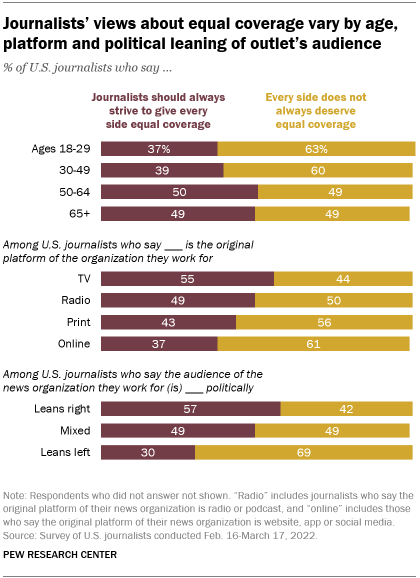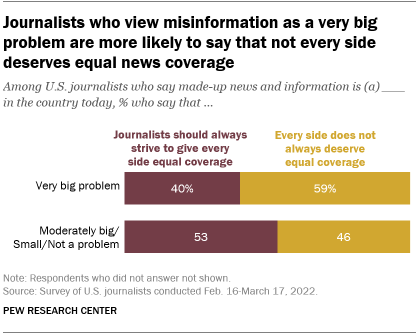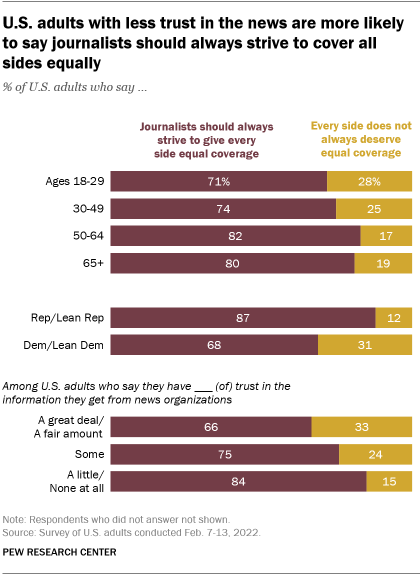Journalists in the United States differ markedly from the general public in their views of “bothsidesism” – whether journalists should always strive to give equal coverage to all sides of an issue – according to a recent Pew Research Center study. A little more than half of the journalists surveyed (55%) say that every side does not always deserve equal coverage in the news. By contrast, 22% of Americans overall say the same, whereas about three-quarters (76%) say journalists should always strive to give all sides equal coverage.

A new analysis of these survey findings shows that attitudes among both journalists and the public differ by age and political factors. Opinions among journalists also vary based on how they view the issue of misinformation, while opinions among Americans overall vary based on their trust in the news.
The issue of whether to try to provide equal coverage to all sides gained new intensity during Donald Trump’s presidency and the widespread disinformation and competing views surrounding the 2020 election and the COVID-19 pandemic. While some feel that equal coverage is always necessary to allow the public to be equally informed about multiple sides of an argument, those who disagree argue that people making false statements or unsupported conjectures do not warrant as much attention as those making factual statements with solid supporting evidence.
The main source of data for this study is a Pew Research Center survey of 11,889 U.S.-based journalists who are currently working in the news industry and said that they report, edit or create original news stories in their current job. The survey was conducted online between Feb. 16 and March 17, 2022. See Appendix for a detailed demographic profile of the journalists who completed the survey.
Because there is no readily available list of all U.S. journalists, Center researchers relied on commercial databases of journalists based in the U.S. as well as supplemental lists of news organizations to create a broad and diverse sample of over 160,000 journalists from as many types of outlets and areas of reporting as possible. Although it is impossible to be certain every segment of the journalism profession in the U.S. is covered by the sample, the use of multiple databases and supplemental lists ensured that journalists from a variety of different reporting areas, news platform types, as well as outlet sizes and types – such as those who work for organizations that are intended to primarily reach a particular demographic group – were represented.
Propensity weighting was used to ensure that the responses of the 11,889 respondents aligned with the full sample of over 160,000 journalists with respect to job titles, media outlet type, freelance status and geographic location.
Read the topline for the questions asked in the survey. For more information on the development of the sample of journalists or the survey weighting, please see the methodology.
The data on the U.S. public comes from a Pew Research Center survey of 9,388 adults conducted Feb. 7-13, 2022. All respondents who took part in this survey are members of the Center’s American Trends Panel, an online survey panel that is recruited through national, random sampling of residential addresses. Recruiting our panelists by phone or mail ensures that nearly all U.S. adults have a chance of selection. This gives us confidence that any sample can represent the whole population (see our Methods 101 explainer on random sampling). To further ensure that each survey reflects a balanced cross-section of the nation, the data is weighted to match the U.S. adult population by gender, race, ethnicity, partisan affiliation, education and other categories.
See the topline for the questions asked in the survey of U.S. adults, along with responses, and its methodology.
This is the latest report in Pew Research Center’s ongoing investigation of the state of news, information and journalism in the digital age, a research program funded by The Pew Charitable Trusts, with generous support from the John S. and James L. Knight Foundation.
Younger journalists, those who say their outlet has a left-leaning audience most likely to say equal coverage not always merited

Roughly six-in-ten U.S. journalists ages 18 to 29 (63%) say every side does not always deserve equal coverage, while 37% of journalists in this age range say journalists should always strive to cover all sides equally – percentages that are very similar to the breakdown among journalists ages 30 to 49. But those numbers change noticeably for journalists 50 and older, who are evenly split between the two viewpoints.
This age gap aligns with another factor: how long journalists have been working in the profession. Those who have been in the industry longer are more likely to support always striving for equal coverage. About half of journalists surveyed who have been working in the news industry for more than 20 years (49%) say journalists should always strive for equal coverage, compared with 38% of those who have been working in the industry for 10 years or less. Those who have worked in the industry for 11 to 20 years fall somewhere in between (43%).
Differences also arise based on the original platform of the outlet journalists work for. Those who say they work at an organization that originated in television are more likely to say that journalists should strive to give every side equal coverage (55%) than those who work at outlets that started in print, radio or online. Conversely, those who work in online media are the least likely to say this (37%).
Journalists’ attitudes also vary by the political leaning of their audience. Overall, 57% of those who say their outlet has a right-leaning audience think the profession should strive for equal coverage, while 42% of these journalists say equal coverage is not always deserved. For journalists who say their outlet’s audience leans left, the trend is reversed, with 30% supporting equal coverage for all sides and a large majority (69%) saying it is not always deserved. Those who say their audiences are politically mixed are evenly divided (49% each).

There is also a notable difference among journalists based on how they view the issue of made-up news and information. Nearly six-in-ten journalists who identify made-up news as a very big problem for the nation today (59%) say all sides do not always deserve equal coverage, while 40% say they do. Journalists who see it as less of a problem – either as a moderately big problem, a small problem or not a problem at all – are more split: 53% support always striving for equal coverage, compared with 46% who say it is not always merited. Overall, 71% of journalists surveyed say made-up news and information is a very big problem for the country.
Republicans, Americans with low levels of trust in news organizations more likely to say journalists should always strive to cover all sides equally

Among the general public, strong majorities in most partisan and demographic groups say each side warrants equal news coverage, but there are some differences by political party and age.
Republicans and independents who lean to the Republican Party are considerably more likely than Democrats and Democratic leaners to say journalists should always strive to give every side equal coverage (87% vs. 68%, respectively).
As is the case among journalists, older adults are the most likely to say all sides warrant equal attention. About eight-in-ten of those ages 50 and older (81%) say this, but the share falls to 74% among those ages 30 to 49 and to 71% among those 18 to 29.
Americans’ attitudes also vary based on the amount of trust they have in the news media. U.S. adults who say they have little or no trust in the information they get from news organizations are more likely than those who have a great deal or fair amount of trust to say journalists should always strive to give every side equal coverage (84% vs. 66%, respectively). Those who have some trust in the news fall in between, with three-quarters of adults in this group saying that journalists should always strive to cover all sides equally.
Note: Here are the questions asked of journalists and U.S. adults for this analysis, along with responses, and its methodology.
